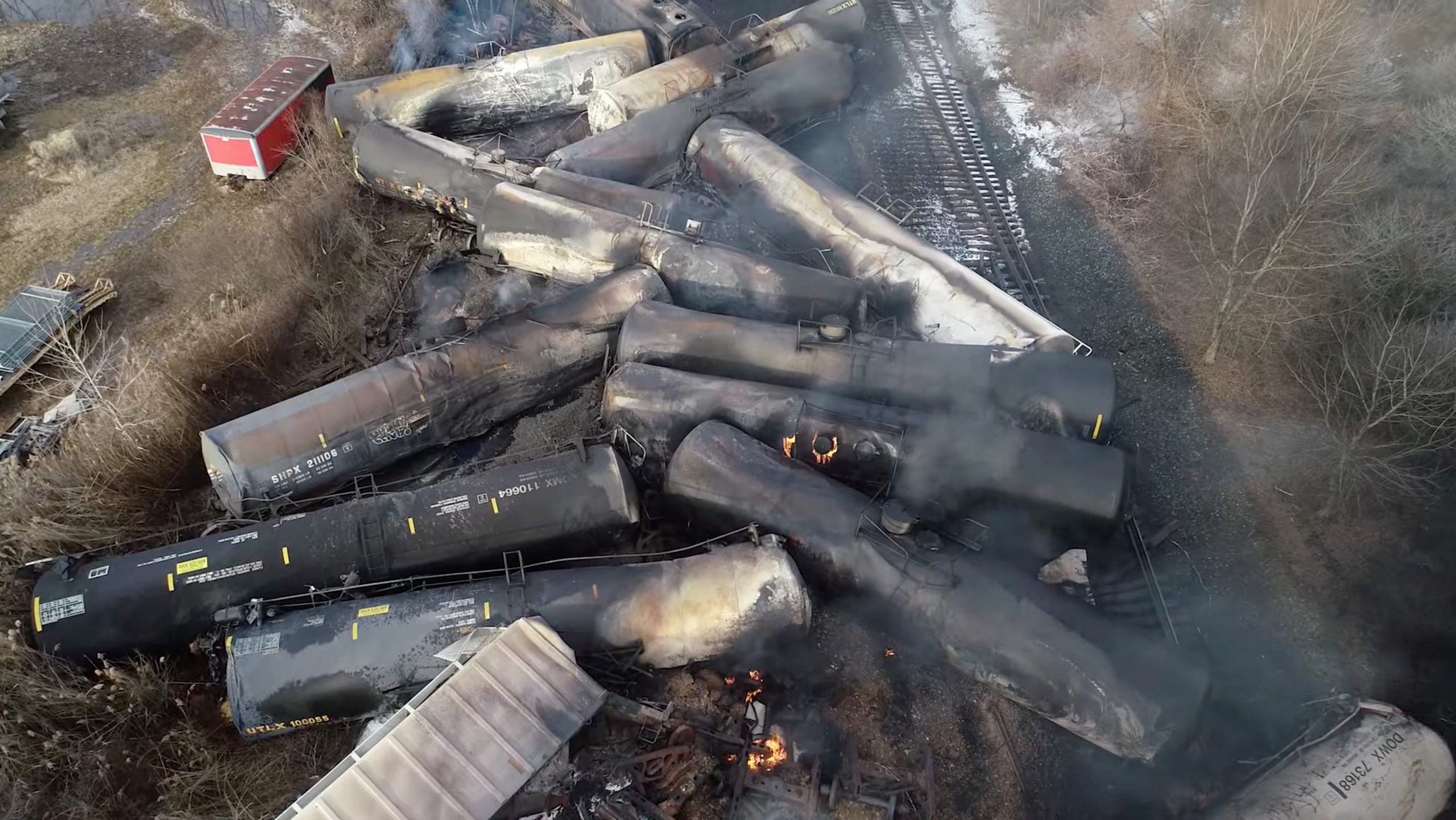
As details of its spilled cargo have come gradually to light, the Ohio train derailment has elicited “worst of all time” pronouncements, and a seemingly growing sense of foreboding as to the long-term consequences.
A statement from the US Environmental Protection Agency (EPA) said around 50 of the train’s 150 cars had been affected by the derailment, which happened on the evening of 3 February as a result of a broken axle. Twenty of these were listed as carrying hazardous chemicals, including several containing vinyl chloride – an industrial chemical used chiefly in the manufacture of PVC, and highly toxic.
Described by the CDC as having “a mild, sweet odour”, vinyl chloride only becomes noticeable at levels far above the legal airborne permissible exposure limits (PEL), defined – in the US – as 1 ppm, for an 8-hour period of exposure, and 5ppm, for 15 minutes. But it is a carcinogen and hence there is arguably no safe limit. In the short-term, explosure to high concentrations causes dizziness, drowsiness and headaches.
In a 10 February letter to the rail operator at the centre of the incident, Norfolk Southern, the EPA referred to vinyl chloride, butyl acrylate, ethylhexyl acrylate and ethylene glycol monobutyl ether, as toxic constituents on board the train, and that these were known to have been released to “the air, surface soils, and surface waters.” Of these, ethylhexyl acrylate is also considered a carcinogen, and is toxic to the lungs and nervous system, while ethylene glycol monobutyl ether is toxic to the liver and kidneys.
A 12 February EPA document seemed to extend the toxic inventory, including three cars of diethylene glycol, one car of polypropyl glycol, one car of propylene glycol, two cars of polyethylene, two cars of polyvinyl and five cars of petroleum.
In the immediate aftermath, EPA air quality monitoring appeared not to have detected contaminants of concern, and had only detected levels of VOCs (such as vinyl chloride and butyl acrylate) below those considered harmful to human health. But reports of powerful odours by those present in the area continued – and continue – to flood news and social media. On 14 February, a local resident Katlyn Schwarzwaelder told the radio host Glen Beck: “Going back is extremely uncomfortable, there are physical symptoms every time, from itchy burning, watery eyes, itchy burning throat, coughing, and a weird sensation like your eyes pulsating like a heartbeat.”
A “controlled burn” of the vinyl chloride aboard five cars was conducted by the EPA on 6 February, prompted by fears of a possible explosion. This operation involved diverting the chemical into a trench and burning it off, as NewScientist explained. Images of the resulting fireball and enormous black smoke cloud have been widely shared on news and social media, and there have been frequent comparisons to Chernobyl.
The by-products of combusting the material in this way include phosgene, a colourless gas that causes vomiting and respiratory problems, known for its use as a chemical weapon in WWI. It is only considered safe (in the US) below 0.1ppm exposure levels during an 8-hour exposure and 0.2ppm for a 15-minute exposure. The combustion will also have produced hydrogen chloride, a colourless to yellow-ish gas, which forms hydrochloric acid in contact with water, and can cause irritation to the eyes, skin, nose and throat. A comparable safe limit for hydrogen chloride exposure is 5ppm (for an 8-hour period of exposure).
Particulate matter is also an obvious constituent of the resulting plume. A NASA air pollution scientist, Ryan Stauffer, tweeted with some alarm on 7 February as he noticed the EPA’s PM2.5 monitor in Youngstown, Ohio – around 20 miles from the crash site – spiking from 12.6 to 34.5μg/m3, suggesting the smoke cloud was moving through surrounding populated areas.
Containing the contaminated water
Contaminated runoff had affected streams in the area, reported the EPA in the immediate aftermath of the crash, on 4 February.
Norfolk Southern contractors have built a dam at the site to try to restrict the flow of contaminated water, and have employed a vacuum truck and absorbent pads to recover spilled chemicals, said NewScientist.
The Ohio state environmental agency also said it had sampled soil at the derailment site and water in surrounding streams, but results would have to await laboratory analysis, although residents have been advised not to drink water from private wells.
Thousands of fish had been killed by the spill according to the Ohio Department of Natural Resources. On social media there were also reports of chickens dying in the aftermath of the crash (and one fox, it was impossible not to notice).
As black clouds swirled overhead in Ohio, the effort to attribute blame also appeared to be progressing rapidly. The EPA sent a “general notice of potential liability” letter to the rail operator Norfolk Southern on 10 February, itemising potential areas of liability.
Reports suggested at least four lawsuits had been filed against the rail operator in the week after the incident, one of which – brought by East Palestine residents – is highly critical of the clean-up operation. “I’m not sure Norfolk Southern could have come up with a worse plan to address this disaster,” said attorney John Morgan, in comments reported in The Independent. “Residents exposed to vinyl chloride may already be undergoing DNA mutations that could linger for years or even decades before manifesting as terrible and deadly cancers.”
At an earlier point in the aftermath, a former freight engineer with the rail operator, Ron Kaminkow, had appeared to point the finger at “ineffective oversight” and workforce cuts, putting “record profits over safety”, in comments made to The Guardian US edition.
Norfolk Southern released a plan for the site’s clean-up on 10 February.







